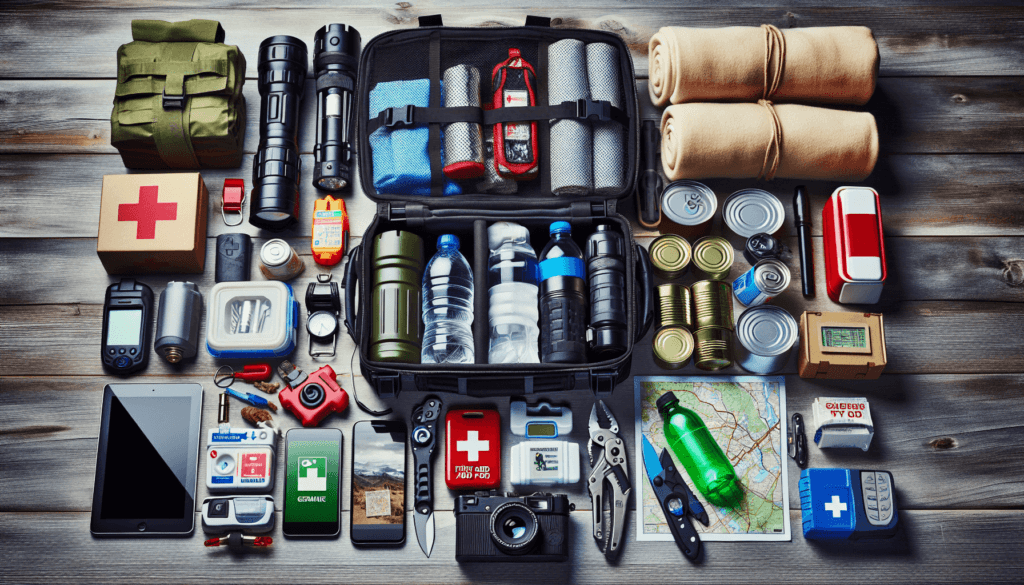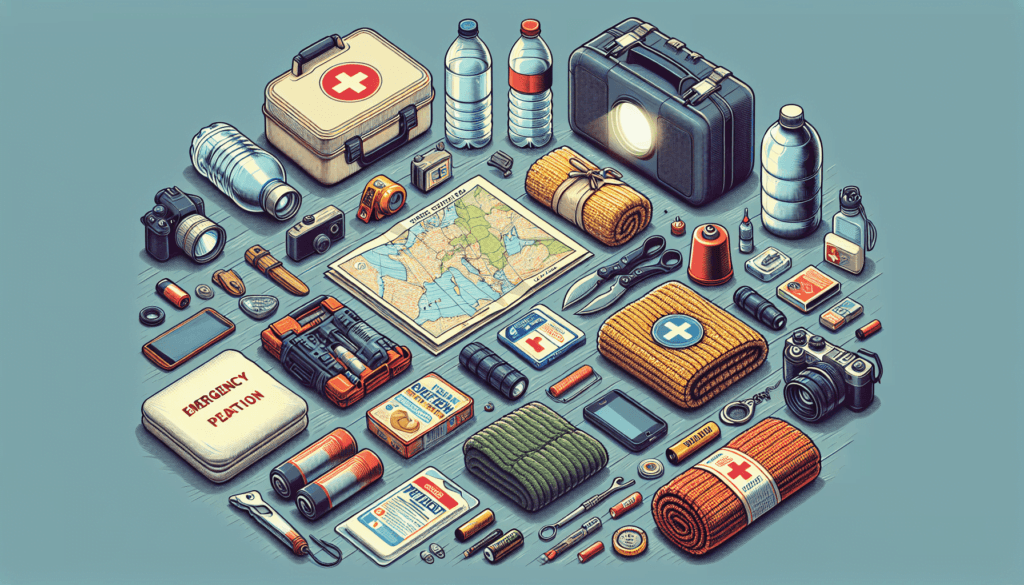In the contemporary landscape marked by escalating climatic disturbances, “Preparing for Natural Disasters: Safety Essentials” offers a comprehensive guide to fortifying your readiness against unpredictable peril. This article meticulously covers critical historical events and emergent trends in natural disaster management, entwining detailed definitions and an insightful analysis of varied perspectives to enrich your understanding. By elucidating key concepts and furnishing real-world case studies underpinned by credible data, it underscores the indispensable measures that ensure safety and resilience. Furthermore, it anticipates future challenges and delineates their broader societal implications, compelling you to recognize the exigency of preparedness in an evolving environmental context.
Table of Contents
Preparing for Natural Disasters: Safety Essentials
Have you ever wondered what steps you should take to ensure your safety and the safety of your loved ones in case of a natural disaster? With the growing frequency and intensity of natural disasters around the world, it’s never been more crucial to be prepared. Whether it’s a hurricane, earthquake, flood, or wildfire, each type of disaster presents unique challenges and risks that require specific preparedness measures.
Overview
Natural disasters can strike without warning, often leaving devastating impacts on communities and individuals. The relevance of being prepared cannot be overstated, as it can mean the difference between life and death. The importance of this topic has only grown in recent years, given the increasing frequency and severity of natural disasters due to climate change and other environmental factors.
Thesis Statement
Effective preparation for natural disasters involves understanding the types of disasters that can occur, being aware of historical and current trends, and developing a comprehensive plan that includes safety essentials. This article aims to provide you with the necessary knowledge and tools to prepare effectively for natural disasters, ensuring the safety and well-being of you and your loved ones.

Historical Context
The history of natural disasters is a long and sobering one, filled with countless examples of devastation and loss. From the catastrophic 1906 San Francisco earthquake to the deadly 2004 Indian Ocean tsunami, these events have shaped our understanding of the forces of nature and underscored the need for preparedness.
Throughout history, communities have developed various methods to mitigate the impact of natural disasters. Early warning systems and building codes have evolved to address specific risks, and international cooperation has been crucial in sharing knowledge and resources. Understanding this historical context helps us appreciate the progress made and the ongoing need for vigilance and innovation.
Current Trends
Recent years have seen an alarming increase in the frequency and severity of natural disasters. According to the National Oceanic and Atmospheric Administration (NOAA), 2020 was a record-breaking year for natural disasters in the United States, with 22 events causing at least $1 billion in damages. Climate change is a significant driver of these trends, contributing to more intense hurricanes, prolonged droughts, and severe wildfires.
These developments have spurred advancements in disaster preparedness and response. Technologies like early warning systems, real-time monitoring, and predictive modeling are increasingly used to enhance readiness and reduce the impact of disasters. The integration of these technologies into preparedness plans is essential for effectively managing the risks associated with natural disasters.

Key Concepts and Definitions
Before diving into the details of disaster preparation, it’s essential to understand some key concepts and terms. Here are a few you should be familiar with:
- Early Warning Systems: Technologies and protocols designed to detect and communicate imminent natural hazards, allowing for timely action to minimize damage and harm.
- Emergency Kit: A collection of essential items needed to survive for at least 72 hours following a disaster. This typically includes food, water, medical supplies, and other necessities.
- Evacuation Plan: A pre-determined strategy for safely moving individuals away from a dangerous area to a safe location, often involving routes, transportation, and shelter details.
- Mitigation: Actions taken to reduce the long-term risk and impact of natural disasters, including structural measures (like building codes) and non-structural measures (like public education).
Detailed Exploration
Identifying Potential Disasters in Your Area
Different regions are susceptible to different types of natural disasters. Knowing what specific disasters are likely in your area is the first step in effective preparation. For example:
- Coastal areas may be prone to hurricanes and storm surges.
- Regions along major fault lines may face earthquakes.
- Flood-prone areas are often near rivers or have poor drainage systems.
- Forested regions might be at risk of wildfires.
Building an Emergency Kit
Your emergency kit should be comprehensive enough to sustain you and your family for at least 72 hours. Here is a list of essential items to include:
| Category | Items |
|---|---|
| Food and Water | Non-perishable food, bottled water (one gallon per person per day) |
| Medical Supplies | First aid kit, prescription medications, personal hygiene items |
| Tools | Flashlight, batteries, multi-tool, whistle, local maps, battery-powered or hand-crank radio |
| Documents | Copies of important documents (ID, insurance policies, medical records) |
| Clothing and Gear | Sturdy shoes, warm clothing, blankets |
| Miscellaneous | Cash, family emergency contacts, child’s comfort items (if applicable) |
Creating an Evacuation Plan
An evacuation plan is crucial for ensuring you can leave your home quickly and safely if necessary. Your plan should include:
- Designated meeting spots for family members
- Pre-determined routes to safe locations
- A communication plan to keep in touch
- Arrangements for pets
Regularly practicing your evacuation plan can help ensure that everyone knows what to do and where to go in an emergency.
Staying Informed
Staying informed about potential threats and current conditions is vital for effective disaster preparedness. Use the following resources to stay updated:
- Local news and weather channels
- Emergency alert systems (e.g., FEMA, NOAA)
- Smartphone apps that provide real-time alerts
Strengthening Your Home and Property
Mitigating damage to your property can significantly enhance safety during a natural disaster. Here are some steps you can take:
- Earthquakes: Secure heavy furniture, install earthquake-resistant fixtures.
- Hurricanes: Install storm shutters, reinforce roofs and doors.
- Floods: Elevate electrical appliances, install sump pumps.
- Wildfires: Clear vegetation around your home, use fire-resistant materials.
Example 1: Preparing for Hurricanes
Consider the case of Hurricane Sandy, which struck the northeastern United States in 2012. The storm caused widespread flooding, power outages, and extensive property damage. Communities that had hurricane preparedness measures in place, such as early warning systems, emergency kits, and evacuation plans, were better able to mitigate the storm’s impact.
According to the Federal Emergency Management Agency (FEMA), effective preparation includes not only having an emergency kit and evacuation plan but also understanding the specific risks hurricanes pose, such as storm surges and high winds. By investing in hurricane shutters, elevating critical infrastructure, and developing robust community response plans, many areas were able to reduce the overall damage and quickly begin recovery efforts.
Example 2: Preparing for Earthquakes
In contrast, consider the case of the 1994 Northridge earthquake in California. The disaster resulted in significant loss of life and property due to the sudden and violent shaking. One of the critical lessons from this earthquake was the importance of retrofitting buildings to withstand seismic activity.
Communities that invested in seismic upgrades, such as flexible building materials and secure foundations, experienced less damage. Additionally, having an emergency plan that included “drop, cover, and hold on” drills and pre-identified safe spots made a significant difference in individual survival rates.
Comparison of Different Perspectives
Preparation for natural disasters often involves a variety of approaches, each with its benefits and challenges. For instance, while technological advancements like early warning systems provide crucial lead time, they require significant investment and maintenance. On the other hand, community-based education and preparedness initiatives can be more accessible and foster a culture of resilience but may lack the immediate impact of high-tech solutions.
Analyzing these different approaches helps to identify a balanced strategy that incorporates both high-tech solutions and community-based preparedness. For example, combining real-time monitoring with widespread public education campaigns ensures that people are not only informed but also know how to act on the information they receive.
Impact Assessment
The effectiveness of different preparedness strategies can be measured by their impact on reducing casualties, property damage, and the time required for recovery. For example, studies have shown that communities with comprehensive disaster education programs and well-practiced evacuation plans experience fewer fatalities and injuries during emergencies. Conversely, areas lacking these measures often face higher casualties and longer recovery times.
Long-Term Impact
Long-term preparedness initiatives, such as investing in resilient infrastructure and promoting sustainable land use practices, also play a crucial role. These measures not only mitigate immediate risks but also contribute to the overall resilience of communities, enabling them to adapt and recover more quickly from future disasters.
Future Directions and Implications
Predictions
The future of disaster preparedness is likely to be shaped by advances in technology and increased global cooperation. Predictive modeling and artificial intelligence could offer more accurate forecasts, while international agreements could facilitate the sharing of resources and knowledge. Climate change is expected to bring more frequent and severe natural disasters, making these advancements even more critical.
Implications
The broader implications of effective disaster preparedness extend beyond individual safety. Prepared communities are better positioned to maintain economic stability, protect critical infrastructure, and minimize environmental degradation. By investing in preparedness measures, we can create more resilient societies capable of withstanding and recovering from the challenges posed by natural disasters.
Conclusion
Recap
Preparing for natural disasters is not just about stocking up on supplies or having an evacuation plan; it involves a comprehensive approach that includes understanding historical trends, staying informed about current threats, and investing in long-term mitigation measures. By being proactive and taking the necessary steps, you can significantly reduce the risks and impacts of natural disasters.
Final Thought
Are you truly ready for the next natural disaster? With the increasing frequency and severity of these events, now is the time to take action. Your preparedness today can make a critical difference in your safety and well-being in the future.
Engagement
We encourage you to share this article with your community and explore additional resources to further enhance your preparedness. By spreading awareness and knowledge, we can collectively build more resilient and safer communities.
Credible Sources
Here are some resources for further reading and to provide transparency:
- National Oceanic and Atmospheric Administration (NOAA)
- Federal Emergency Management Agency (FEMA)
- American Red Cross
- World Bank Group – Natural Disaster Risk Management
- Journal of Emergency Management
By utilizing credible sources and staying informed, you can ensure that you are well-prepared for any natural disaster that may come your way.
Related site – The Ultimate Guide to Emergency Preparedness and Response

